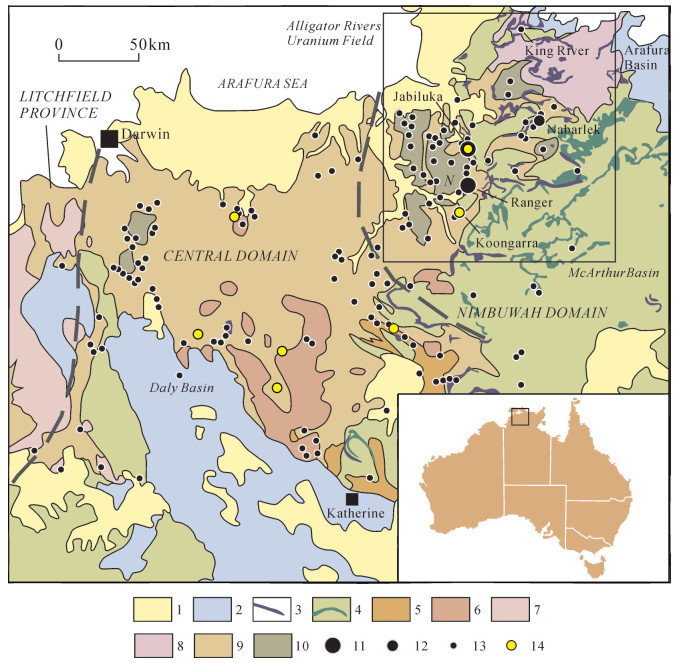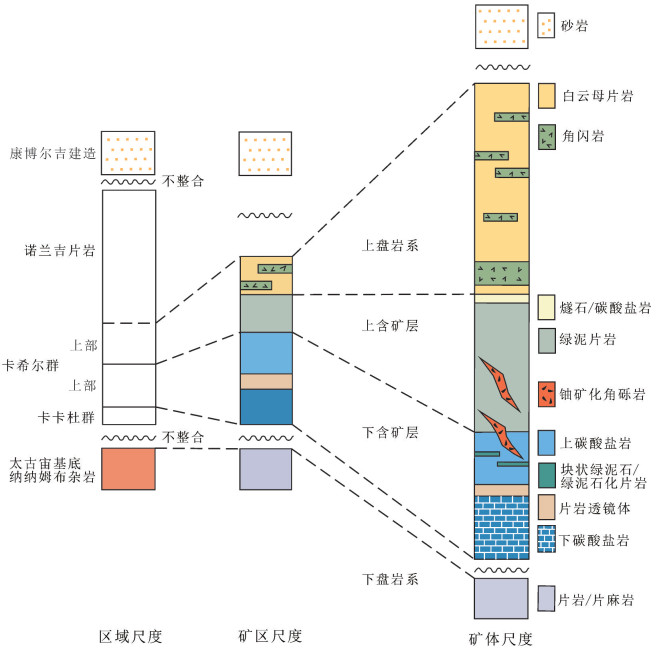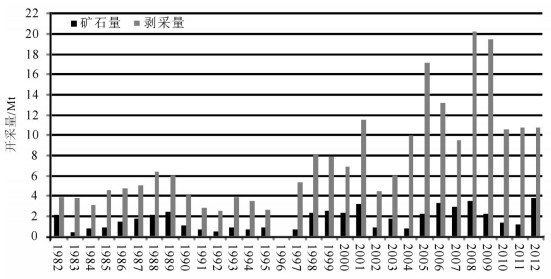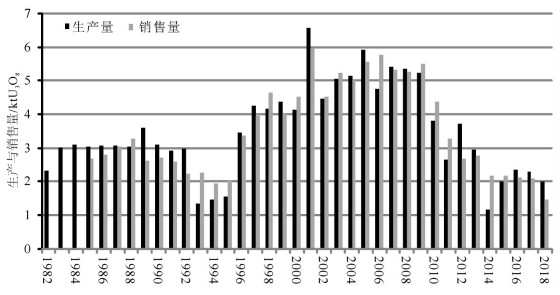The life of Ranger 1 uranium mine in Australia: Geology, resources, production and rehabilitation
-
摘要:
兰杰一号铀矿及其所属的鳄鱼河铀矿田产于北澳太古宙克拉通内古元古代裂谷背景下发展起来的松溪造山带,矿体产于新太古代-古元古代结晶-变质基底/晚古元古代-中元古代康博尔吉红层建造不整合界面之下,铀矿化分3个时代,U1为1720~1680Ma,U2为1420~1040Ma,U3为474±6Ma,U1是主矿化时代。该矿床于1969年后期通过航空放射性测量被发现,1970's经勘探圈定了No.1和No.3两个铀矿体,总计资源储量124681t@0.23% U3O8。1980年10月正式露采,至2018年12月,总计生产了128739t U3O8。1985财年开始,ERA(澳大利亚能源资源有限责任公司)向世界核能市场共计销售了产于兰杰铀矿的119882t U3O8。2009年,发现了No.3深部矿,探明资源储量为43857t@0.22% U3O8,这部分资源将以地下开采方式利用。预计到2026年,采区地貌景观和生态环境将得到恢复。进一步讨论了澳北元古宙不整合面型铀矿找矿的方向,持续稳定的铀矿开采与生产的意义,以及投资澳大利亚铀矿业需要注意的政治与法律问题。这些内容可以为国内矿业企业及地勘单位合理部署澳洲铀矿勘查与开发提供参考。
Abstract:The tectonic setting of Ranger uranium deposit, also ARUF, is Pine Creek orogen, which was developed from the Paleoproterozoic rift in the Archean craton of North Australia. The orebodies lie under the interface between the Neoarchaean-Paleoproterozoic crystallization-metamorphic basement and Late Paleo-Mesoproterozoic Kombolgie red bed formations. There are three epochs of uranium mineralization, which are U1:1720~1680Ma, U2:1420~1040Ma and U3:474±6Ma. U1 is the main mineralization epoch.The deposit was discovered by aerial radioactivity survey in late 1969. No. 1 and No. 3 orebodies were delineated by exploration in the 1970's, with a total resource of 124681t@0.23% U3O8. From October 1980 to December 2018, a total of 128739t U3O8 was produced by open-pit mining. Since fiscal year 1985, ERA has sold 119882t U3O8 from Ranger uranium mine to the nuclear energy market in the world. In 2009, No. 3 deep orebody was discovered, with reserves of 43857t@0.22% U3O8, which will be exploited by underground mining. It is expected that the geomorphological landscape and ecological environment of the mining area will be restored by 2026.This paper further discusses the prospecting direction of Proterozoic unconformity uranium deposits in northern Australia, the significance of sustained and stable uranium mining and production, and the political and legal issues that need attention in investing in Australian uranium mining. These contents can provide references for China's mining enterprises and geological exploration units to rationally deploy Australian uranium exploration and development.
-

-
图 1 兰杰铀矿位置①
Figure 1.
图 2 松溪造山带区域地质图[4]
Figure 2.
图 3 兰杰铀矿区域—矿区—矿体尺度岩石地层[20]
Figure 3.
图 4 兰杰铀矿No.1和No.3矿体岩石地层和构造[20]
Figure 4.
图 5 兰杰铀矿1982—2012财年采矿量/剥采量统计图(数据据参考文献①)
Figure 5.
图 6 兰杰铀矿1982—2018财年铀生产与销售量统计图(数据据参考文献①)
Figure 6.
表 1 兰杰铀矿资源储量①
Table 1. Resources list of Ranger uranium mine
矿体 资源储量类型 矿石量/104t 品位/% U3O8 金属量/t U3O8 金属量/t U No.1 探明的(proven) 15.56 0.336 52292 44344 控制的(Probabale) 0.31 0.191 586 497 小计 15.87 0.333 52878 44841 No.3 控制的(Probabale) 23.62 0.182 43100 36549 推断的(Possible) 14.47 0.198 28703 24340 小计 38.09 0.188 71803 60889 合计 53.96 0.231 124681 105730 注:No.1矿体边界品位0.1%,No.3矿体边界品位0.05% 表 2 ERA股份结构①
Table 2. List of ERA's share structure
级别 股东 股份/千股 占比/% A类
普通股澳大利亚电锌公司(EZ) 125000 30.49 Peko-Wallsend公司 125000 30.49 澳大利亚公众 57500 14.02 B类
普通股Rheinbraun澳大利亚公司 25625 6.25 UG澳大利亚发展有限公司 16400 4.00 Interuranium澳大利亚公司 15375 3.75 OKG Aktiebolag 4100 1.00 C类
普通股日本澳铀资源开发有限公司 41000 10.00 合计 410000 100.00 -
[1] NEA, IAEA. Uranium 2016:Resources, Production and Demand[J]. OECD Publishing, 2017. http://d.old.wanfangdata.com.cn/NSTLQK/NSTL_QKJJ0213281296/
[2] Lally J H, Bajwah Z U. Uranium deposits of the Northern Territory[J]. Northern Territory Geological Survey, 2006. http://d.old.wanfangdata.com.cn/NSTLQK/10.2113-gsecongeo.82.4.857/
[3] Pirajnoa F, Bagas L. A review of Australia's Proterozoic mineral systems and genetic models[J]. Precambrian Research, 2008, 166(1):54-80. http://www.wanfangdata.com.cn/details/detail.do?_type=perio&id=74d928f221385e2e6bdae7a587805f0d
[4] Skirrow R G, Mercadier J, Armstrong R, et al. The Ranger uranium deposit, northern Australia:Timing constraints, regional and ore-related alteration, and genetic implications for unconformityrelated mineralisation[J]. Ore Geology Reviews, 2016, 76:463-503. doi: 10.1016/j.oregeorev.2015.09.001
[5] Worden K, Carson C, Scrimgeour I, et al. A revised Palaeoproterozoic chronostratigraphy for the Pine Creek Orogen, northern Australia:evidence from SHRIMP U-Pb zircon geochronology[J]. Precambrian Research, 2008, 166(1):122-144. http://cn.bing.com/academic/profile?id=a9739426af7ecc06f3cb3cf6c17c45e1&encoded=0&v=paper_preview&mkt=zh-cn
[6] Hollis J A, Carson C J, Glass L M. SHRIMP U-Pb zircon geochronological evidence for Neoarchean basement in western Arnhem Land, northern Australia[J]. Precambrian Research, 2009, 174(3):364-380. http://www.wanfangdata.com.cn/details/detail.do?_type=perio&id=69f5a34446803829932021ed55d33a52
[7] Hollis J A, Glass L M, Carson C J, et al. The geological evolution of the Pine Creek Orogen: new pieces in the puzzle on orogen and craton scale[C]//Annual Geoscience Exploration Seminar (AGES). 2011.
[8] Hollis J A, Wygralak A S. A review of the geology and uranium, gold and iron ore deposits of the Pine Creek Oroge[J]. Episodes News Mag. 2012, 35(1):264-272. doi: 10.18814/epiiugs/2012/v35i1/026
[9] Annesley I R, Madore C, Kwok Y Y, et al. U-Pb geochronology and petrochemistry of late Barramundi pegmatites from the Ranger U deposit, Northern Territory, Australia[C]//Uranium deposits. International workshop, Prague, 2002: 37-40.
[10] Stuart-Smith P G, Needham R S, Page R W, et al. Geology and mineral deposits of the Cullen mineral filed, Northern Territory[J]. Bureau of Mineral Resources, Geology and Geophysics, Bulletin, 1993, 229:67-77. https://www.worldcat.org/title/geology-and-mineral-deposits-of-the-cullen-mineral-field-northern-territory/oclc/29483429
[11] Page R W, Needham R S, Compston W. Geochronology and Evolution of the Late-Archaean Basement and Proterozoic Rocks in the Alligator Rivers Uranium Field, Northern Territory, Australia[C]//Ferguson J, Gobely A B. Uranium in the Pine Creek Geosyncline. IAEA, Vienna, 1980: 39-68.
[12] Mercadier J, Skirrow R G, Cross A J. Uranium and gold deposits in the Pine Creek Orogen (North Australian Craton):a link at 1.8Ga?[J]. Precambrian Research, 2013, 238:111-119. doi: 10.1016/j.precamres.2013.10.001
[13] Needham R S, StuartSmith P G. Geology of the Alligator Rivers Uranium Field, Northern Territory[J]. Bureau of Mineral Resources, Geology and Geophysics, Bulletin, 1988:1-224. http://cn.bing.com/academic/profile?id=e64eaa2b990f7bbb3e683f6968407a24&encoded=0&v=paper_preview&mkt=zh-cn
[14] Bull S W, Rogers J R. Recognition and significance of an early compressional deformation event in the Tawallah Group, McArthur Basin.[C]//NT.MIC'96. New developments in Metallogenic Research, 1996: 28-32.
[15] Scott D L, Rawlings D J, Page R W, et al. Basement framework and geodynamic evolution of the Palaeoproterozoic superbasins of north-central Australia:an integrated review of geochemical, geochronological and geophysical data[J]. Journal of the Geological Society of Australia, 2000, 47(3):341-380. http://cn.bing.com/academic/profile?id=2a5e7c0ac75232c05586b047352e187e&encoded=0&v=paper_preview&mkt=zh-cn
[16] Polito P A, Kyser T K, Marlatt J, et al. Significance of alteration assemblages for the origin and evolution of the Proterozoic Nabarlek unconformity-related uranium deposit, Northern Territory, Australia[J]. Economic Geology, 2004, 99(1):113-139. http://cn.bing.com/academic/profile?id=7ed24a983bdf35dc7caf5c98090c5835&encoded=0&v=paper_preview&mkt=zh-cn
[17] Polito P A, Kyser T K, Thomas D, et al. Re-evaluation of the petrogenesis of the Proterozoic Jabiluka unconformity-related uranium deposit, Northern Territory, Australia[J]. Mineralium Deposita, 2005, 40(3):257-288. doi: 10.1007/s00126-005-0007-9
[18] Hiatt E E, Kyser T K, Fayek M, et al. Early quartz cements and evolution of paleohydraulic properties of basal sandstones in three Paleoproterozoic continental basins:evidence from in situ δ18O analysis of quartz cements[J]. Chemical Geology, 2007, 238(1):19-37. http://www.sciencedirect.com/science/article/pii/S0009254106004864
[19] Sweet I P, Brakel A T, Carson L. The Kombolgie Subgroup a newlook at an old formation[J]. Journal of Earth Sciences, 1999, 45(219):232.
[20] McCoy A, Pope A, Schaubs P. Structural Setting of the Ranger Uranium Orebodies, Implications for Exploration[C]//AusIMM International Uranium Conference, 2009.
[21] Hein K A A. Geology of the Ranger Uranium Mine, Northern Territory, Australia:structural constraints on the timing of uranium emplacement[J]. Ore Geology Reviews, 2002, 20(34):83-108. http://cn.bing.com/academic/profile?id=b96ec52bd28680736ad2881900977259&encoded=0&v=paper_preview&mkt=zh-cn
[22] Kendall C J. Ranger uranium deposits[C]//Hughes F E. Geology of the mineral deposits of Australia and Papua New Guinea. The Australasian Institute of Mining and Metallurgy, 1990, 1: 799-805.
[23] Savory P J. Geology and grade control at ERA-Ranger Mine, Northern Territory, Australia[C]//Hallenstein C P. Australian Mining Looks North-The Challenges and Choices. AusIMM Annual Conference. The Australian Institute of Mining and Metallurgy, Melbourne, 1994: 97-101.
[24] Hegge M R, Rowntree J C. Geologic setting and concepts on the origin of uranium deposits in the East Alligator River Region, N.T., Australia[J]. Economic Geology, 1978, 73(8):1420-1429. doi: 10.2113/gsecongeo.73.8.1420
[25] 汪诗明, 王艳芬.论《兰杰协定》的签署[J].华东师范大学(哲学社会科学版), 2016, 48(5):102-111. http://www.cnki.com.cn/Article/CJFDTotal-HDSD201605021.htm
① ERA. Annual Report 1981—2018[EB/OL](2019-04-01)[2019-04-01]http://www.energyres.com.au/media/reports/.
② IAEA. Questionnaire to Member States, 2017/2018[EB/OL](2018-08-20)[2019-03-20]https://infcis.iaea.org/NFCIS/FacilityDetails/266?Country=Australia&Status=All&Type=All&Scale=All&SText=2018.
-



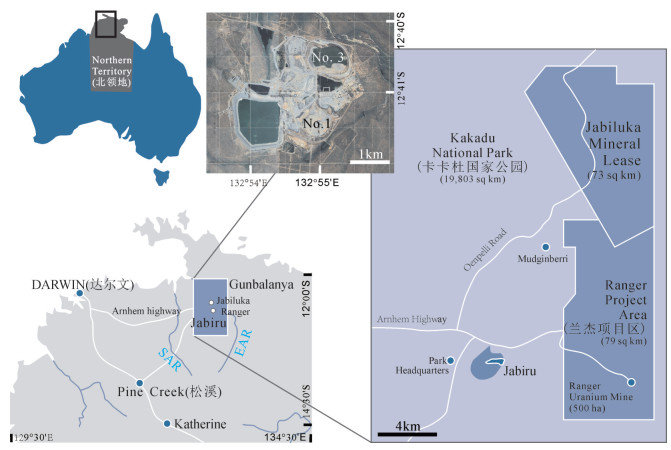
 下载:
下载:
